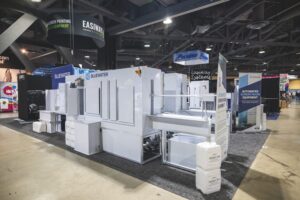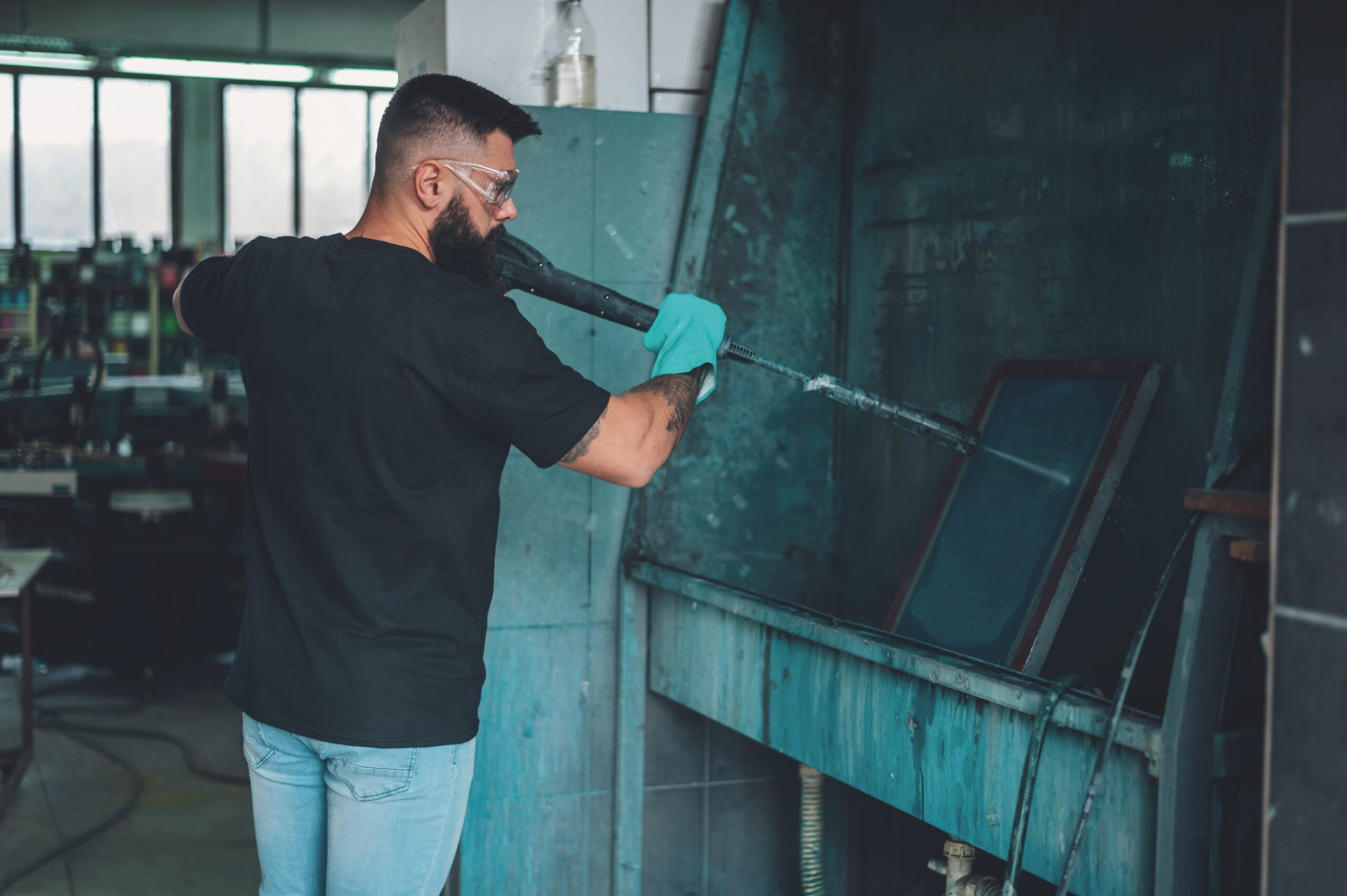The job of prepping a custom T-shirt shop’s screen-printing screens for re-use is critical to success
Screen reclamation, in addition to being far and away the least glamorous part of T-shirt screen printing, is also, arguably, one of the most important parts of the process as well. Efficient screen reclamation ensures your screens are thoroughly cleaned and ready for their next turn on the press, thereby directly impacting the overall quality of your prints. Alas, for all too many screen-printing shops, the messy, labor-intensive nature of the work can lead to high turnover among those employees tasked with handling it—the exact opposite of what you want.
By making screen reclamation efficient, eco-conscious and user-friendly, you can improve the quality of your apparel printing at the same time you alleviate worker frustration. For larger shops, especially, going with an automated system can also help reduce costs by reducing the number of man hours involved and the quantity of cleaning solutions required. It can also make it that much easier to reduce your environmental footprint, thanks to the filtering systems that are part and parcel of this type of equipment.
The following is a brief overview of some of the key techniques, tools and systems screen-printing shops large and small can use to elevate their screen reclamation process in the interest of bettering their shop’s overall performance.
Why Screen-Printing Screen Reclamation is Important for Success
Screen reclaiming serves as the foundation of a quality custom apparel printing business as it influences every other aspect of a shop’s workflow, not to mention customer satisfaction. Quality screens result in quality prints, less wastage and less printer downtime. Among the many specific reasons effective, efficient reclamation stands out as a critical function are:
Quality Assurance:
A reclaimed screen free of ink stains, ghost images, grease and old emulsion allows for better exposed screens, resulting in crisp, vibrant images.
Cost Savings:
Prolonging the life of your screens by properly reclaiming them reduces the need to replace them frequently. It also means having to spend less time troubleshoot poorly exposed screens or having to reclaim/expose poorly processed screens all over again.
Workplace Efficiency:
Efficiently reclaimed screens reduce downtime, allowing operators to focus on production and other important tasks.
Improved Employee Morale:
Implementing safe, user-friendly reclamation tools can reduce the job’s physical burdens, motivating your team to do its best and reducing/preventing turnover.
Environmental Responsibility:
Proper reclamation minimizes chemical waste, keeps harmful substances out of water supplies and ensures compliance with local environmental laws.
Techniques for Screen Reclamation, Manual vs. Automated Systems
Screen reclamation typically involves the following steps, each requiring a specific set of tools, chemicals and processes to achieve optimal results.
Manual Screen Reclamation:
Manual reclamation makes sense financially for smaller operations, but it is messy, requires a fair bit of physical effort and close attention to detail. Again, there’s nothing like a poorly reclaimed screen to throw a wrench into the works.
1.Tools Needed for Manual Screen Reclamation
- A washout booth or area
- Pressure washer
- Cleaning solvents
- Scrub brushes (a separate one for each type of solvent used to prevent cross contamination)
- Personal protective equipment (PPE), including eye protection and gloves
2. The Process of Manual Screen Reclamation
- Ink Removal: While still on the press, use a squeegee to remove as much of the ink as possible, leaving just a film on the screen itself. Spray the screen with ink remover, let it sit briefly then wipe with a clean rag. After that, spray with a pressure washer in your shop’s washout booth/area.
- Emulsion Removal: Once most of the ink is gone, spray the screen with emulsion remover, let it sit briefly and then spray with a pressure washer to remove the liquified emulsion. Fingers crossed the screen is now ink and emulsion free. But don’t bet on it!
- Final Cleaning: If any blotches or “ghost” images remain, spray with a haze removing solution and/or degreaser, scrub, let sit and pressure wash. The screen should now be stain- and “ghost image” free. Let dry in preparation for the next round of printing.
Automatic Screen Reclamation Systems:
As should be obvious from the overview above, it’s a rare individual who won’t do everything he or she can to avoid manual screen reclamation. Granted, for screen-printers just starting out, screen reclamation may not be a problem. The moment a shop starts growing, though, the need for effective screen reclamation invariably becomes problematic.

The step-by-step nature of screen reclamation readily lends itself to the linear layouts found in automated systems like this Bluewater model. Photo courtesy of Impressions Expo
For all these reasons, automating a larger shop’s screen reclamation process can be a great way to save time, money and effort, not to mention boost morale. Automated systems, like M&R’s Eco-Tex line, Bluewater Labs Inline Reclaim line or ROQ’s newly released JetBlack Automatic Screen Reclaim System, which include multiple spraying and rinsing stations, can make all the difference in the world for those companies looking for a better way to process their used screens.
1. How Automated Screen Reclamation Systems Work
- Chemicals Application: Today’s systems feature separate spray nozzles to apply ink removers, emulsion removers and de-hazers in distinct chambers
- Dip Tanks: In some cases, there is an initial dip-tank step to help soften the emulsion at the beginning of the reclaim process
- Chemical Recirculation: Many systems recirculate chemicals to reduce waste, minimize the process’s environmental footprint and improve efficiency.
- Automated Rinsing: High-powered nozzles perform consistent washing without the risk of human error.
- Conveyor Systems: The step-by-step nature of the reclamation process readily lends itself to the inline format adopted by today’s automated systems, with a fully integrated conveyor moving the screens from station to station.
2. Standout features of today’s automated reclaim systems include:
- Surprisingly compact designs to save space in your shop
- Protection against chemical cross-contamination by keeping the different inline stations isolated from one another
- High-speed processing for 10–20 screens per hour
At the end of the day, automated systems, while requiring a higher initial investment, offer long-term benefits that will often quickly outweigh their costs by reducing labor dependency, increasing efficiency and improving operational cleanliness.
Optimizing the Manual Screen Reclamation Process
Of course, the downside to an automated reclamation system, is the aforementioned cost. When printing/reclaiming at scale, the ROI/cost per screen quickly becomes a no-brainer. However, we’re talking dozens of screens per day here. Smaller shops processing fewer screens therefore have no choice but to continue to reclaim manually. Luckily, there are a number of tools out there to make the process as efficient and pleasant as possible.
Screen Printing Washout Booths
Despite the fact many veteran screen printers never seem to tire of reminiscing about the lousy washout booths they worked with in their youth—think grungy plywood contraptions wrapped in plastic or even grungier old bathtubs—don’t be like these veterans! Do yourself—and your employees!—a favor and invest in a decent washout booth, robustly constructed out of corrosion-free polypropylene or stainless steel. Key features to look for include:
- Backlighting: Allowing operators to clearly see how clean the screen they are working on is
- Filtration Friendly Drainage: In addition to being bad for the environment (and illegal in many places) simply letting your dissolved ink and emulsion go down the drain is a great way to destroy your shop’s plumbing.
- Brackets for Screens: A sturdy rack, or racks for securing screens is crucial for efficient, effective processing. If there is a shelf or bracket or two for securing brushes or a spray nozzle, all the better.
Screen Reclamation Dip Tanks
Dip tanks simplify emulsion removal by soaking screens in specialized solutions. In the same way some automated systems include dip tanks, including a dip tank as part of your company’s manual screen reclamation station will make the process that much more efficient and effective.
Filtration Systems for Ink, Emulsion
Effective filtration is crucial in order to comply with environmental regulations and prevent clogs in your shop’s plumbing.
High-Pressure Screen Washers
Sure, you could go with a plain-old garden hose and spray attachment, but why? Industrial pressure washers are not just ideal for ensuring thorough rinses and efficient emulsion removal, ensuring clean, ready-to-use screens, they are also much faster.
Again, whether it’s creating impeccable prints or reducing your shop’s environmental impact, effective screen reclamation impacts virtually every aspect of your business. Leveraging tools like automatic reclamation systems, dip tanks and robust filtration systems will make it possible for your shop to deliver quality products at the same time it alleviates the burden on employees.





